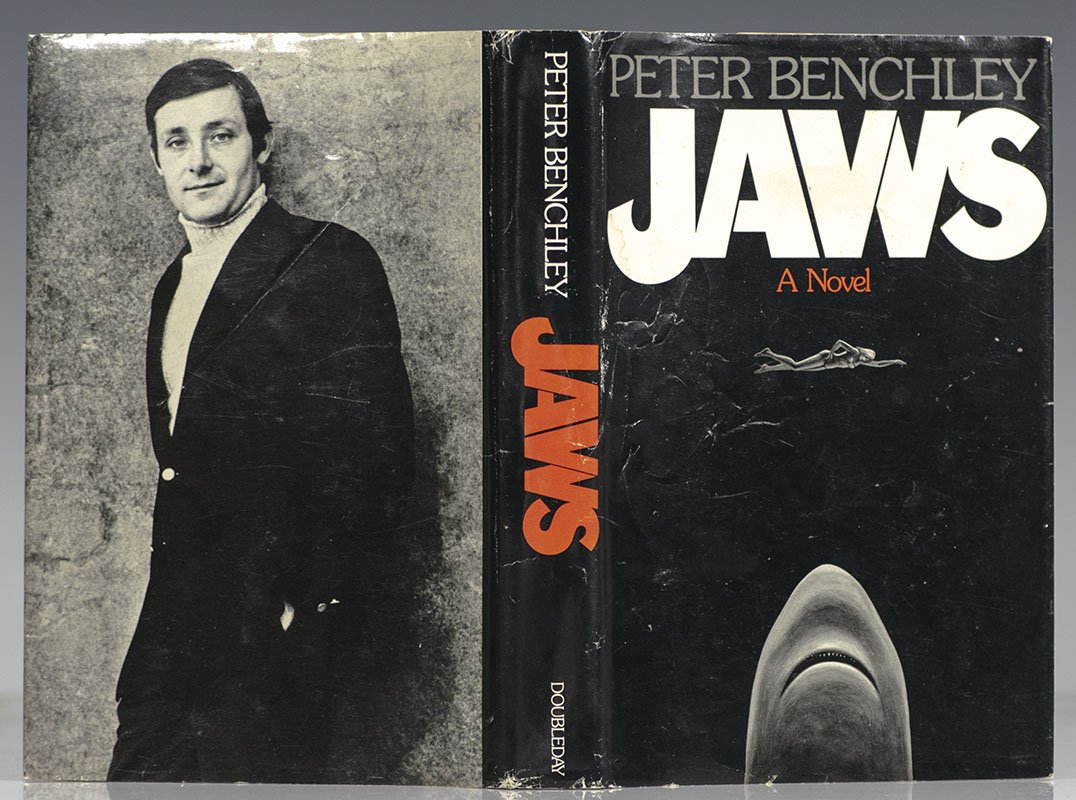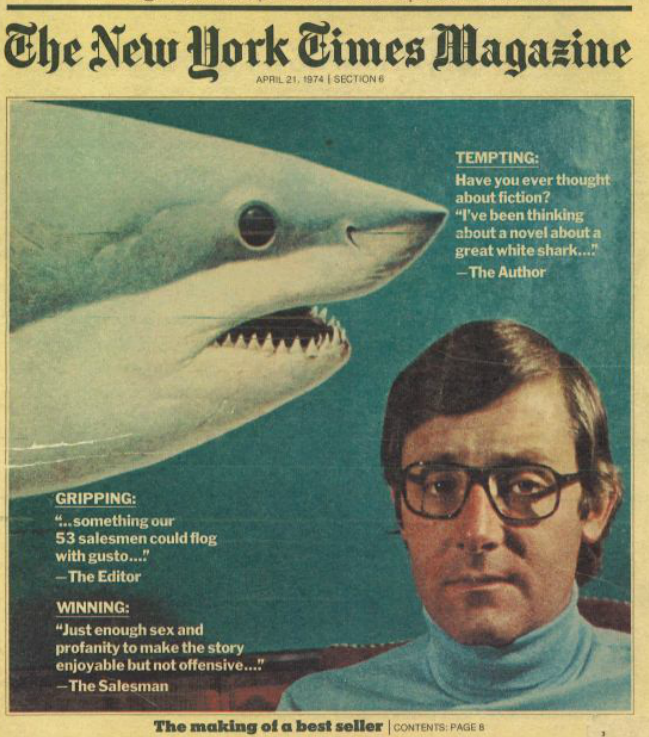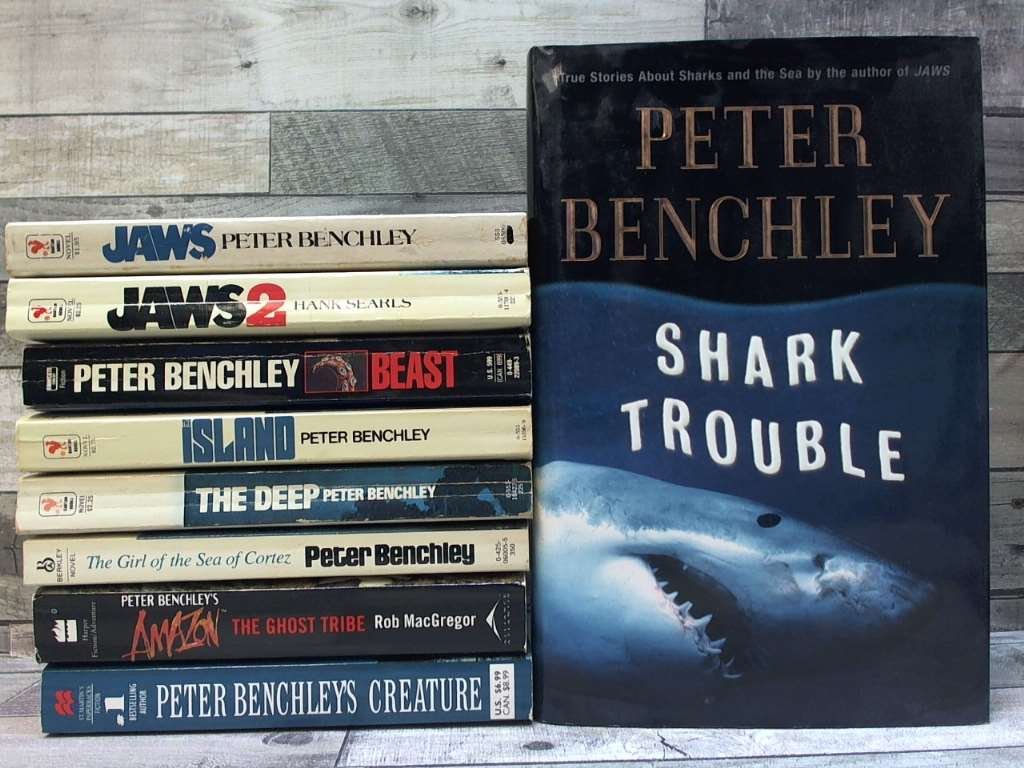From the White House to White sharks: A profile of JAWS author Peter Benchley
Peter Bradford Benchley entered the world amidst the bustling streets of New York City on 8 May 1940.
Over the ensuing six and a half decades, he emerged as a prominent figure in global conservation efforts, earning widespread recognition and respect. Leveraging the fame garnered from his involvement with "Jaws," he utilized his platform to raise awareness about the escalating threats facing sharks, marine life, and the fragile ecosystems of our oceans.
Born to Nathaniel Benchley, a notable writer and scion of the Benchley lineage, which included the renowned humorist and actor Robert Benchley, Peter's upbringing was rich with literary and artistic influences. His formative years were marked by the upheavals of World War II, during which his father served in the U.S. Navy in various theaters of the conflict. Amidst the turmoil, Peter and his mother, Marjorie, split their time between the urban vibrancy of New York City and the serene landscapes of Colorado.
Following the war, the family resettled in New York City, where Peter attended grade school before matriculating to Phillips Exeter Academy in New Hampshire, graduating in 1957. Subsequently, he pursued higher education at Harvard College, graduating in 1961 with a degree in English. It was during his time at Harvard that Peter's latent passion for writing began to bloom, nurtured by his father, who recognized his son's aptitude and offered him paid writing opportunities during his summer breaks. Reflecting on this period in an interview with Brett Gilliam, author of "Diving Pioneers and Innovators," Peter fondly recalled his early forays into the world of literature.
Following his college years, he embarked on a year-long journey around the globe, funded by a student grant. This expedition served as the inspiration for his debut book, TIME AND A TICKET, which hit the shelves in 1964. Simultaneously, he delved into the realm of children's literature, publishing JONATHAN VISITS THE WHITE HOUSE, a work that foreshadowed his future endeavors.
Transitioning into a brief stint with the U.S. Marine Corps through a six-month reserve program, he concluded his service with an honorable discharge, marking the start of his civilian life. Joining the ranks of prestigious publications, he began his career at The Washington Post before making his mark as an editor at Newsweek magazine. The invaluable journalistic skills honed and the network of contacts forged during his tenure at these esteemed publications would prove instrumental in shaping his future successes.
In the same transformative year of 1964, he exchanged vows with Wendy Wesson, embarking on a new chapter of his personal life. Meanwhile, the cinematic adaptation of his father Nathaniel's 1961 novel, THE OFF-ISLANDERS, under the direction of Norman Jewison, emerged as "The Russians Are Coming, the Russians Are Coming," further enriching the family's legacy in the world of literature and film.
In 1967, Peter assumed the role of speechwriter for President Lyndon Johnson, prompting a relocation to Washington, DC for both him and Wendy. However, with the conclusion of Johnson's presidency in January 1969, they resettled in New Jersey, marking the commencement of Peter's career as a freelance writer and reporter. His repertoire encompassed diverse subjects, from travelogues to film critiques, freelance television projects to compiling news stories – any endeavor that promised financial remuneration. Much of the research he conducted during this period would later find its way into his novels and articles.
One idea had been germinating in Peter's mind for years, sparked by a memorable fishing excursion off the shores of Nantucket with his father and friends. As they sought game fish in the Atlantic, the frequent sightings of sharks, their fins slicing through the water, left an indelible impression on Peter. In the 1960s, he stumbled upon a tale of a fisherman who had ensnared a colossal 4,550-pound great white shark off Long Island. This anecdote, coupled with the notion of a coastal resort community akin to Nantucket, dependent on its bustling summer tourism, sparked a question in Peter's mind: What havoc could such a creature wreak if it encroached upon the resort's waters and refused to depart? Thus, this concept simmered in his imagination for years, awaiting its moment of fruition.
After years of juggling his time between writing television and newspaper pieces, Peter found himself with enough space in 1971 to fully develop the tale of an audacious shark disrupting a summer haven. Encouraged by his editor, he summoned the discipline inherited from his father. Winter days were dedicated to crafting the story in the back room of the Pennington, NJ, Furnace Supply Co., while summer days were spent in an old turkey coop in Stonington, CT. It was in these disparate settings that he meticulously crafted what would eventually evolve into JAWS.
As Peter described his reaction to having his first novel published:
“Nobody thought Jaws would be a success. It was a first novel, and nobody reads first novels. It was a novel about a fish, for God’s sake, and who cared about fish? ..... So we called it Jaws, and put it to bed, and that, for the time being, was that.”
Everything changed in 1974.
The novel found its way into the hands of various book clubs and caught the attention of esteemed film producers David Brown and Richard Zanuck, marking the commencement of Peter and Wendy's global journey.
Peter was enlisted to pen the initial drafts of the screenplay for "Jaws," a project spearheaded by Zanuck and Brown, who also brought onboard the budding yet promising director Steven Spielberg and seasoned screenwriter Carl Gottlieb. Production crews embarked on shoots in Martha's Vineyard and Australia, while Bob Mattey's team toiled in California to craft a mechanical shark that would captivate even the most discerning audiences. Notably, the daring diving exploits of Ron and Val Taylor captured much of the Australian footage.
Gottlieb's book, "THE JAWS LOG," offers insightful glimpses into the behind-the-scenes machinations of the film, with Peter contributing an introduction to its 25th anniversary edition. Additionally, Peter fondly recalls cherished anecdotes from this adventure in the videos featured in our "Jaws Behind the Scenes" section.
The global success of "Jaws" propelled Peter and Wendy into a sphere populated by talented underwater filmmakers, explorers, and researchers, many of whom would become integral to his future endeavors. Notably, Peter forged a lasting and fruitful collaboration with renowned underwater photographer David Doubilet, spanning magazine articles, films, commercial ventures, and other projects over the ensuing four decades. Among their remarkable collaborations was the 2000 National Geographic article and accompanying video titled "Great White Shark: Truth Behind the Legend."
Peter infused his extensive research findings with a generous dose of imagination to craft seven additional novels and multiple non-fiction works.
Inspired by his explorations in Bermuda and the wealth of knowledge shared by Teddy Tucker, a prominent Bermudian treasure and salvage diver whom Peter encountered during a 1971 assignment, THE DEEP (1976) delves into the intriguing tale of the Constellation shipwreck. Nestled atop two ancient Spanish vessels, the Constellation's cargo of drugs provides a fertile backdrop for a gripping narrative. Recognizing the adage that truth can indeed be stranger than fiction, Peter ingeniously weaves a story around the ship's treasure trove of gold, rather than the historical reality. The subsequent film adaptation in 1977, directed by Peter Yates and featuring Nick Nolte, Jacqueline Bisset, and Robert Shaw, met with resounding success.
Stan Waterman, a trailblazing filmmaker and close confidant of Peter's, contributed much of the underwater footage for "The Deep." Their partnership extended beyond this project, encompassing numerous television and film ventures worldwide. Al Giddings, another luminary in underwater photography, served as the principal underwater director.
Drawing from his research into piracy and the enigmatic aura of the Bermuda Triangle, as well as indulging in speculative "what if" scenarios, Peter crafted THE ISLAND (1979). This novel, which was adapted into a 1980 film starring Michael Caine and David Warner, intertwines historical intrigue with imaginative speculation, captivating audiences with its tantalizing narrative.
Throughout this period, Peter also penned and featured in numerous television documentaries focusing on marine life and oceanic exploration, contributing to series like "The American Sportsman" and "Spirit of Adventure." Many of these documentaries were captured through the lens of acclaimed filmmaker Stan Waterman.
In 1982, inspired by a captivating real-life experience, Peter crafted a poignant ode to the oceans and their inhabitants in THE GIRL OF THE SEA OF CORTEZ. This heartfelt narrative stemmed from a memorable filming expedition in the Sea of Cortez, accompanied by Stan Waterman and esteemed photographers Howard and Michele Hall. During the expedition, Michele found herself alone on the boat, encountering a majestic manta ray with a troubling entanglement. Displaying remarkable courage and compassion, Michele donned scuba gear and delicately freed the ray from its plight, tenderly tending to its injured wing. In a remarkable display of trust, the ray allowed Michele to ride upon its back as it gracefully glided through the water. As the crew reunited, Michele shared her extraordinary encounter, sparking awe and wonder among them. To their astonishment, the ray returned, inviting them all to share in its aquatic journey over the ensuing days.
Peter’s excitement at his ride is barely contained in his description:
“I felt like a fighter pilot—no, not a pilot, for I had no control over this craft; rather, like a passenger in a fighter plane. Down we flew, and banked around the sea mount, and soared again. We passed turtles that didn’t give us a passing glance and hammerheads that (I swear) did a double take as they saw us go by. The world grew dark, and for a moment I was afraid—I knew we had gone very deep, but I had no way of knowing exactly how deep because I couldn’t let go with one hand to retrieve my depth gauge. If we’re too deep, I worried, I’ll run out of air, or get the bends on surfacing, or—Just then, as if to reassure me, the manta returned to the world of light. It rushed for the surface, gaining speed with every thrust of itsmighty wings, and I had the sudden, terrifying conviction that it was going to burst through the surface and take to the air—and me with it—and when we slammed down again on the water I would be reduced to pudding. But long before it reached the surface, the manta swerved away and began to cruise twenty or thirty feet below the boat. Finally, it slowed, then silently stopped directly in the shadow of the boat. I let go and made my way to the surface.”
The cinematic portrayal of this extraordinary encounter is truly awe-inspiring, as is the compelling 1981 National Geographic article.
Moved profoundly by this profound interaction, Peter hastened home to pen a tale exploring the delicate balance between conservation and commerce, a narrative that continues to resonate with readers and holds a cherished place on many lists of favorite books. Today, new generations are introduced to the timeless allure of this story, passed down by parents who have cherished it for decades.
Drawing once more from his personal encounters and extensive research, Peter's subsequent novel ventured into the realm of picaresque comedy and adventure. Released in 1986, Q CLEARANCE follows the misadventures of a White House speechwriter who finds himself embroiled in unexpected turmoil while endeavoring to craft witty rhetoric for the Leader of the Free World.
In addition to his literary exploits, Peter shared insights from his own life in the 1989 comedy-adventure RUMMIES, offering a humorous yet poignant "cautionary tale" centered around a New York editor grappling with denial about his drinking problem, ultimately finding himself compelled to confront his demons in rehab. This story, ahead of its time in its treatment of addiction and recovery, injects humor into a subject often approached with solemnity.
Q CLEARANCE and RUMMIES stand as two of Peter’s most overlooked novels.
In 1991, he returned to his beloved sea and the realm of adventure with BEAST, a captivating "what if" tale centered around a colossal squid, drawing from his extensive research. While the story may appear fantastical, speculation among scientists and fishermen about the existence of massive squid in the ocean's depths lends credence to its premise. Recent discoveries have only reinforced the plausibility of such creatures. This compelling narrative was adapted into a highly acclaimed NBC-TV miniseries in 1996, featuring William Petersen and Karen Sillas.
Continuing his exploration of speculative fiction, Peter penned WHITE SHARK in 1994, delving into the consequences of scientific experimentation gone awry. The story was later adapted into a TV miniseries titled "Creature," starring Craig T. Nelson and Kim Cattrall in 1998.
In 1989, Peter crafted the pilot for the potential TV series "Dolphin Cove," centered around a marine biologist's adventures.
From 1999 to 2000, Peter enjoyed success with his syndicated TV series "Peter Benchley’s Amazon," a thrilling saga following the survivors of a plane crash in the heart of the Amazon jungle, encountering a host of fantastical creatures and characters. Notably, Peter embraced a role as a leper in some episodes, adding a touch of irony to the storyline that anticipated the popular TV series "Lost."
In his later years, Peter shifted his focus to non-fiction works, primarily advocating for oceanic and environmental causes. He co-authored OCEAN PLANET (1995) with Judith Gradwohl, serving as a text-and-picture companion to a Smithsonian Institution exhibition.
Peter chronicled his encounters with sharks in SHARK TROUBLE (2002), later releasing an edition tailored for teenagers titled SHARK LIFE (2005), offering vivid descriptions of his experiences with various shark species, which can be explored in the Shark Gallery.
When discussing his motivation behind consolidating his extensive knowledge about sharks, Peter remarked:
“Shark Trouble was not intended at all as a mea culpa, for several reasons. I don’t feel a bit of guilt about Jaws. The book made use of the best information that was available 30 years ago. It was as realistic as I could make it. Great white sharks had done every single thing that happened in the book, though not all at once and certainly not one single shark. Over the years, Jaws has brought a great deal of positive Attention to the plight of sharks and the ocean. I still get about a thousand letters a year from kids who weren’t alive when the book was published or the movie released, and they all express fascination and adoration for sharks. The conservation work I’ve done since – and do still – is the result of education and growth: mine. I’ve grown up with the environmental movement, and with what I – we all – know now, I couldn’t possibly write Jaws today. Last summer’s hysteria was dumb, hideous and downright wrong! I campaigned against it all summer, and in the fall it became the genesis of Shark Trouble. I wanted to write something that set the record straight and pointed out how the Internet makes us all vulnerable to distortions, wild exaggerations, and outright lies.”
For numerous years, he collaborated closely with Dr. Gregory Stone of the New England Aquarium, engaging in writing, producing, and hosting a series of short films tackling critical marine issues such as endangered species, global warming, and bycatch. Sponsored by the Fidelity Foundation and in conjunction with the Bermuda Underwater Exploration Institute, these films have been generously donated to aquariums and museums worldwide.
As the host and narrator of "Ocean Report," he delivered daily radio segments aired on over 100 public radio stations from 1997 to 2000.
From the early 1970s to the early 2000s, he contributed numerous articles to esteemed publications such as The National Geographic and The New York Times.
In his capacity as a marine conservationist, Peter dedicated the latter part of his life to volunteering his expertise and time to various causes and organizations. Delivering hundreds of speeches and producing numerous documentary films, he tirelessly endeavored to raise awareness about the grave threats facing our oceans. His profound fascination with marine life permeated his environmental and conservationist endeavors, illuminating his passionate advocacy.
Among his earliest advocacies was his support for the great white shark. Despite the initial negative impact of "Jaws," which cast a shadow over the species, it eventually sparked a widespread fascination, respect, and affection for these majestic creatures. Peter's activism played a pivotal role in advancing the cause of championing and respecting these highly sophisticated animals.
He played a pivotal role as one of the founding figures behind the extraordinary Bermuda Underwater Exploration Institute (BUEI), an institution offering visitors an immersive journey into the depths of the ocean. Within its walls, visitors encounter remarkable collections of seashells, marine life, and treasures salvaged from wrecks on the Bermuda reefs. Educational segments provide simulated experiences, allowing guests to embark on virtual rides in submersible submarines and shark cages. Conceived as a tribute to the decades-long exploration and discoveries of Teddy Tucker, Peter's esteemed underwater mentor and a living legend in his own right.
Throughout his four decades in the public eye, Peter and Wendy traversed the globe on numerous occasions, engaging in exploration, research, and collaboration with some of the foremost scientists and adventurers in the field of oceanography. They contributed their expertise in various capacities, serving on the boards and advisory committees of esteemed organizations such as the National Council of the Environmental Defense Fund, the Center for Sustainable Fisheries at the Rosenstiel School of Marine and Atmospheric Sciences at the University of Miami, Wild Aid, the New England Aquarium, and the Mote Marine Laboratory.
Peter passed away at his home in Princeton, NJ, on February 12, 2006.
Wendy, along with many of Peter's colleagues in the expansive realms of oceanographic sciences and marine conservation, continues his legacy of environmental advocacy and conservation efforts.
If you would like to write for The Daily Jaws, please visit our ‘work with us’ page
For all the latest Jaws, shark and shark movie news, follow The Daily Jaws on Instagram, Twitter and Facebook.












